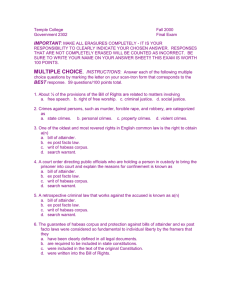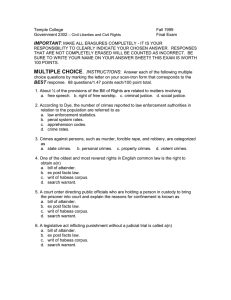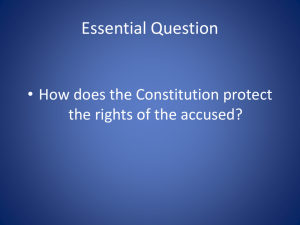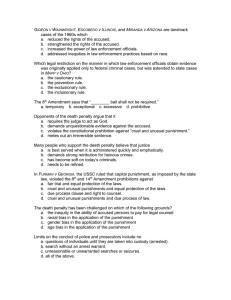MULTIPLE CHOICE INSTRUCTIONS
advertisement
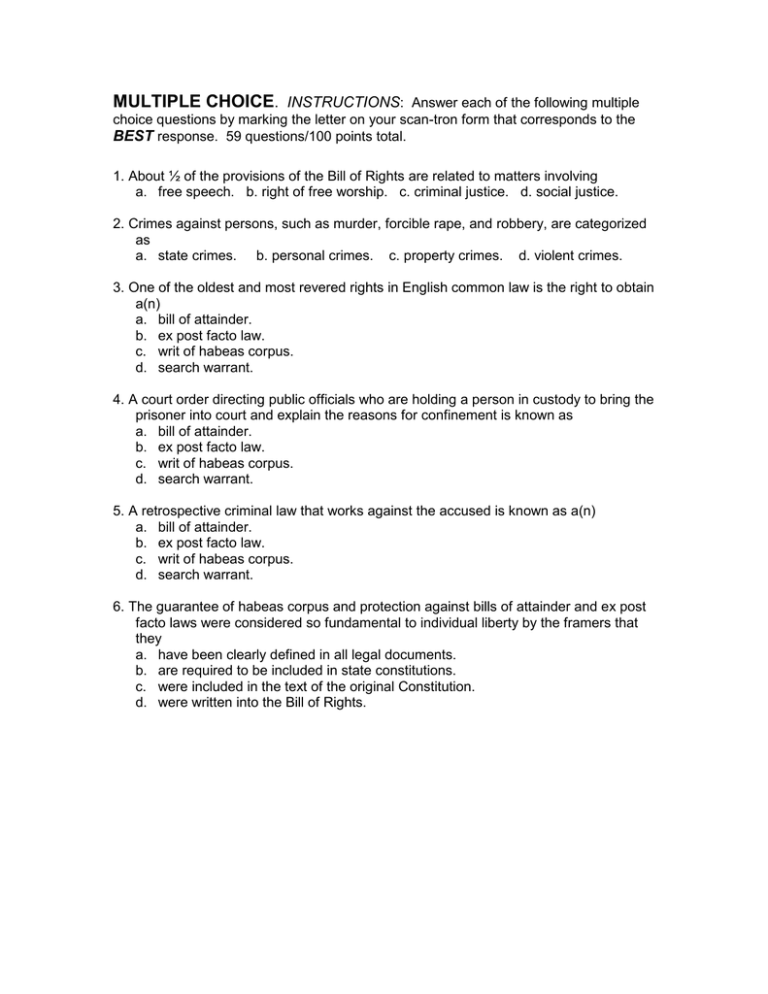
MULTIPLE CHOICE. INSTRUCTIONS: Answer each of the following multiple choice questions by marking the letter on your scan-tron form that corresponds to the BEST response. 59 questions/100 points total. 1. About ½ of the provisions of the Bill of Rights are related to matters involving a. free speech. b. right of free worship. c. criminal justice. d. social justice. 2. Crimes against persons, such as murder, forcible rape, and robbery, are categorized as a. state crimes. b. personal crimes. c. property crimes. d. violent crimes. 3. One of the oldest and most revered rights in English common law is the right to obtain a(n) a. bill of attainder. b. ex post facto law. c. writ of habeas corpus. d. search warrant. 4. A court order directing public officials who are holding a person in custody to bring the prisoner into court and explain the reasons for confinement is known as a. bill of attainder. b. ex post facto law. c. writ of habeas corpus. d. search warrant. 5. A retrospective criminal law that works against the accused is known as a(n) a. bill of attainder. b. ex post facto law. c. writ of habeas corpus. d. search warrant. 6. The guarantee of habeas corpus and protection against bills of attainder and ex post facto laws were considered so fundamental to individual liberty by the framers that they a. have been clearly defined in all legal documents. b. are required to be included in state constitutions. c. were included in the text of the original Constitution. d. were written into the Bill of Rights. 7. A court order permitting law enforcement officials to search a location in order to seize evidence pertaining to a crime is a(n) a. bill of attainder. b. ex post facto law. c. writ of habeas corpus. d. search warrant. 8. Freedom from self-incrimination was originally designed to prevent persons from a. fleeing from the authorities. b. taking their own lives after arrest. c. being tortured into confessions of guilt. d. blaming the crime on others. 9. The standard phrase in today’s culture for “I refuse to answer that question on the grounds that it might tend to incriminate me” is a. “I stand corrected.” b. “Anything said may be used against you.” c. “I take the 5th.” d. “I want to call my attorney.” 10. A grant by the government to an individual of freedom from prosecution on a particular charge in return for testimony by that individual that might otherwise be self-incriminating is a. plea bargaining. b. immunity from prosecution. c. prosecution protection. d. the exclusionary rule. 11. GIDEON V WAINWRIGHT, ESCOBEDO V ILLINOIS, and MIRANDA V ARIZONA are landmark cases of the 1960s which a. reduced the rights of the accused. b. strengthened the rights of the accused. c. increased the power of law enforcement officials. d. addressed inequities in law enforcement practices based on race. 12. Which legal restriction on the manner in which law enforcement officials obtain evidence was originally applied only to federal criminal cases, but was extended to state cases in MAPP V OHIO? a. the cautionary rule. b. the prevention rule. c. the exclusionary rule. d. the inclusionary rule. 13. The 8th Amendment says that “________ bail shall not be required.” a. temporary b. exceptional c. excessive d. prohibitive 14. Pretrial release on bail can be denied on the basis of all of the following except a. the seriousness of the crime. b. the trustworthiness of the defendant. c. public safety is threatened. d. governor’s conditional pardon. 15. If a jury cannot reach a unanimous decision in a criminal case, the judge declares a a. double jeopardy. b. divided jury. c. hung jury. d. retrial. 16. The practice of allowing defendants to plead guilty to lesser crimes than those with which they were originally charged in return for reduced sentences is known as a. double jeopardy. b. bargain basement justice. c. plea bargaining. d. retrial. 17. Opponents of the death penalty argue that it a. requires the judge to act as God. b. demands unquestionable evidence against the accused. c. violates the constitutional prohibition against “cruel and unusual punishment.” d. metes out an irreversible sentence. 18. Many people who support the death penalty believe that justice a. is best served when it is administered quickly and emphatically. b. demands strong retribution for heinous crimes. c. has become soft on today’s criminals. d. needs to be refined. 19. In FURMAN V GEORGIA, the USSC ruled that capital punishment, as imposed by the state law, violated the 8th and 14th Amendment prohibitions against a. fair trial and equal protection of the laws. b. cruel and unusual punishments and equal protection of the laws. c. due process clause and right to counsel. d. cruel and unusual punishments and due process of law. 20. The death penalty has been challenged on which of the following grounds? a. the inequity in the ability of accused persons to pay for legal counsel b. racial bias in the application of the punishment c. gender bias in the application of the punishment d. age bias in the application of the punishment 21. Limits on the conduct of police and prosecutors include no a. questions of individuals until they are taken into custody (arrested). b. search without an arrest warrant. c. unreasonable or unwarranted searches or seizures. d. all of the above. 22. The exclusionary rule is a policy a. forbidding the admission of illegally seized evidence. b. which prohibits the arresting officer from serving as a character witness at a hearing or a trial. c. which prohibits the detention of a suspect for more than 48 hours without formal charges being filed. d. none of the above. 23. Suppose the police take a suspect into custody for questioning. Which of the following would hold? 1. The suspect is entitled to have an attorney present during questioning. 2. The suspect has the right to refuse to answer questions. 3. If the police release the suspect without filing criminal charges, they are prevented from taking the person into custody later. 4. If the suspect confesses to the crime, even after he has been read his Miranda rights, the state cannot use the confession to prosecute the suspect. 5. The suspect is entitled to a court-appointed attorney at the state’s expense if he cannot afford to pay for his own legal counsel. a. all of the above b. 1 and 2 c. 1, 2, and 4 d. 1, 2, and 5 24. In which of the following scenarios would evidence seized by the police during a search be excluded (suppressed) from criminal trial? In other words, in which scenario would the exclusionary rule apply? a. The police go to the home of a school guidance counselor after receiving several complaints from parents about the behavior of the man with respect to their children. The police charge him with indecency with a child upon finding, in his home, photographs of naked children. The man gave the police permission to search his residence, but the police failed to obtain a search warrant. b. The police search the trunk of a woman’s car after presenting a warrant in good faith, but the warrant is “technically” flawed. The police find heroin in the trunk and charge the woman with possession of a controlled substance with intent to sell. c. Without obtaining a search warrant, the police search a closet in a man’s apartment after the man’s neighbor informs them that the man has illegal guns stored there. The police find the remains of a missing woman and charge the man with murder. d. The exclusionary rule would apply in all of these scenarios [the evidence would be suppressed in each case]. 25. In which of the following scenarios would the respective statement (confession) be inadmissible in a criminal trial? a. A man walks into a police station and confesses that he is a serial killer. b. The police arrive at the scene of a fatal car crash and find a man lying on the ground next to the passenger side of one of the vehicles. They ask the man where the driver is and responds, “I was driving and I am drunk.” They charge the man with DWI and vehicular manslaughter since the driver of the other car was dead on the scene. c. The police receive an anonymous phone tip about a man keeping large amounts of cash in his apartment. The police stake out the man’s apartment and decide that he is likely the same man videotaped by a bank’s security cameras during a recent robbery. Outside his apartment, the police ask the man where he got all the money he’s been spending lately. He tells them he got it from the bank he robbed. The police arrest him and charge him with armed robbery. d. The statements in each of these scenarios would be inadmissible because the police failed to administer the suspects’ Miranda warnings. 26. Which of the following was not one of the provisions found in the original Constitution in 1787 regarding slavery? a. Slaves were to be counted as 3/5 of a person. b. Authorities must train and educate new slaves. c. It prohibited any federal restriction on the importation of slaves until 1808. d. It guaranteed the return of escaped slaves to their owners. 27. A social movement in the antebellum United States whose goal was to end the practice of slavery was known as the a. anti-slavery drive. b. women’s movement. c. abolition movement. d. temperance movement. 28. Abraham Lincoln’s edict on January 1, 1862, which declared “all persons held as slaves within any State, or designated part of a State, the people whereof shall then be in rebellion against the United States, shall be then, thenceforward, and forever free,’ is called the a. Magna Carta. b. Declaration of Independence. c. Declaration of Rights and Grievances. d. Emancipation Proclamation. 29. While Lincoln’s statement in the previous question freed the slaves in the States which had seceded, the 13th Amendment, ratified in 1865 a. legitimized Lincoln’s edict. b. abolished slavery everywhere in the United States. c. made the freed slaves eligible for welfare services. d. eliminated all voting taxes so freed slaves could vote. 30. The Supreme Court rulings in 1883 that declared all federal civil rights laws prohibiting discrimination by private individuals to be unconstitutional are known as the a. Discriminatory Laws. b. Laws of 1883. c. Rights of All Decisions. d. Civil Rights Cases. 31. Segregation became the social instrument by which African-Americans were “kept in their place” through such devices as a. Abe’s Boys Laws. b. Jim Crow laws. c. the color-blind standard. d. none of these. 32. De jure segregation means racial segregation a. that has been eliminated by a state grand jury. b. that is based on cultural differences. c. of French immigrants prior to the 20th century. d. that occurs because of laws or government decisions. 33. In 1896, the Supreme Court ruled in PLESSY V FERGUSON that a. African-Americans are NOT defined as persons under the Constitution. b. the government has the power to force all people to treat each other as equals. c. schools may not practice any type of racial segregation. d. separation of races is not a violation of the 14th Amendment's "equal protection of the laws" clause. 34. In PLESSY V FERGUSON, the USSC upheld a. voting rights for freed slaves. b. Funding for public housing. c. State laws requiring segregation. d. Federal laws requiring segregation. 35. In PLESSY V FERGUSON, which of the following legal doctrines did the USSC find to be consistent with the 14th Amendment’s Equal Protection Clause? a. Jim Crowism b. separate-but-equal c. color blindness d. separate accommodations rule 36. According to Dye, the initial goal of the black civil rights movement was to a. achieve freedom for the southern slaves. b. obtain employment opportunities for the freed slaves. c. eliminate segregation laws, especially in education. d. provide education opportunities for the children of slaves. 37. According to Dye, initially the strategy for the National Association for the Advancement of Colored People (NAACP) focused on a. enlarging the membership of the organization. b. enlisting members from all over the nation. c. enlisting prominent whites as members. d. achieving the “equal” portion of the “separate, but equal” doctrine. 38. Thurgood Marshall’s goal, which went farther than the NAACP’s, was to prove that a. black people should be included in the census count for state representation in Congress. b. Segregation itself was inherently unequal whether or not facilities were equal in all tangible respects. c. The color blind standard was antiquated and should be abolished. d. Segregation was acceptable if blacks shared equal opportunities. 39. According to Dye, the USSC’s decision in BROWN V BOARD OF EDUCATION stimulated black hopes and expectations and a. started the modern black civil rights movement. b. ended all racial discrimination. c. began a period of reconciliation. d. concluded a period of racial unrest. 40. In the BROWN case, the USSC did not order immediate national desegregation; rather it required state and local authorities to proceed a. before being ordered to do so by federal officials. b. without any further interference from national officials. c. with “all deliberate speed.” d. in a manner that would conform to local, county, and state “vantage points.” 41. The South Carolina case, SWANN V CHARLOTTE-MECHLENBURG (1971), upheld a. the elimination of Jim Crow laws in public schools. b. supervision by federal officials in local elections. c. equal opportunity employment in all educational levels. d. court-ordered busing of pupils to achieve racial balance. 42. According to Dye, while the early goal of the civil rights movement was to eliminate discrimination practiced by governments, the latter focus moved to a. community discrimination. b. educational discrimination. c. employment discrimination. d. private discrimination. 43. According to Dye, the 1960s legislation that ranks with the Emancipation Proclamation, the 14th Amendment, and the BROWN case as one of the most important steps toward full equality for African-Americans is the a. Civil Rights Act of 1964. b. Voting Rights Act of 1965. c. Civil Rights Act of 1968. d. Equal Rights Amendment of 1972. 44. Which of the following is NOT a provision of the 1964 Civil Rights Act? a. unlawful to discriminate in any public accommodation b. end discrimination in all programs receiving federal aid c. established the Equal Employment Opportunity Commission d. guarantee voting rights for all adult citizens 45. The last major civil rights problem addressed by the Congress in the 1968 Civil Rights Act was discrimination in a. education. b. employment. c. sale and rental of housing. d. registering and voting in state and national elections. 46. Any program, whether enacted by a government or by a private organization, whose goal is to overcome the results of past unequal treatment of minorities and/or women by giving members of these groups preferential treatment in admissions, hiring, promotions, or other aspects of life is called a. positive action. b. affirmative action. c. preferential treatment. d. special accommodations. 47. A provision of some affirmative action programs in which specific numbers or percentages of positions are open only to minorities and/or women is a a. proportional representation. b. quorum. c. quota. d. plurality. 48. Established by the Civil Rights Act of 1964, the agency responsible for monitoring affirmative action programs in private employment is the a. Quality Quota Council. b. Equal Quota of Employees Commission. c. Equal Quorum of Employing Agencies. d. Equal Employment Opportunity Commission. 49. A USSC decision in 1989 made it more difficult to prove job discrimination by requiring plaintiffs to prove that a. they were not promoted because they were minorities. b. Employment practices show favoritism to white males. c. They were not reimbursed for educational expenses to upgrade their skills. d. An employer had no business reason for requirements or tests that ad an adverse impact on minorities and women. 50. Two of the major provisions in the 1991 Civil Rights and Women’s Equity Act were statistical imbalances and a. equalization of employment benefits. b. Removal of “glass ceiling” impediments. c. Disparate employment practices. d. Group opportunities. 51. The current position of the federal courts on the issue of affirmative action (as it applies to The University of Texas Law School’s admission program) is that a. quota systems are an acceptable means to achieve racial equality. b. The university may set aside a certain number of admission slots for minority applicants. c. The university may not take race into consideration in its admission practices. d. None of these. 52. Why did the U.S. Supreme Court declare unconstitutional the provisions of the Civil Rights Acts of 1865-1877 which made discrimination against blacks by private actors (hotel/motel keepers, restaurant owners, and other providers of public accommodations, etc.) illegal? a. The 14th Amendment was not to be ratified by the States for another 100 years. b. The members of the Supreme Court were segregationists and believed that such discrimination preserved the supremacy of the white race. c. The members of the Supreme Court believed that the 14th Amendment only gave Congress the authority to prevent discrimination by the States in their official (governmental) acts. d. None of these. 53. Which provision of the Constitution did the Supreme Court use in cases in the 1960s to uphold congressional efforts to prohibit discrimination by private actors? a. the Supremacy Clause b. the necessary and proper clause c. the interstate commerce clause d. the General Welfare clause 54. Political support for the civil rights laws has weakened because there is increasing resentment among whites regarding a. the number of minorities in the legal and medical fields. b. The lack of political participation of minorities. c. Deferential treatment of minorities. d. Preferential treatment of minorities. 55. Which of the following was NOT among the progressive protections for women won by activists in the early 1900s? a. limiting number of hours of work b. improving working conditions c. addressing physical demands d. increasing minimum wage 56. In the early 20th century, the feminist movement concentrated on women’s suffrage, or the a. attempt to reduce the suffering of women in the workplace. b. requirement for women to be subordinate to men. c. drive to guarantee women the right to vote. d. push to expand women’s admittance into traditional male professions. 57. As a result of the failure to ratify the Equal Rights Amendment, today, women are dependent upon the a. sensitivity of elected officials. b. Laws of Congress. c. Changing interpretations of the male Supreme Court justices. d. Revision attempts of state constitutions. 58. The argument that pay levels for traditionally male and traditionally female jobs should be equalized by paying equally all jobs that are “worth about the same” to an employer is referred to as a. direct discrimination. b. comparable worth. c. equal compensation. d. compensatory compensation. 59. The “invisible” barriers to women rising to the highest positions in corporations and the professions is called the a. pink ladder. b. frilly office. c. glass ceiling. d. slippery floor. 60. Which of the following is generally true of social regulatory politics? 1. Single-issue interest groups tend to promote uncompromising, absolutist positions on social regulatory issues. 2. Courts have a tendency to decide cases in favor of individual liberties at the expense of broader community values. 3. Presidents generally play an important role in the formation of substantive social regulatory policies. 4. Congress has a tendency to pass legislation supporting broader community values at the expense of individual liberties. 5. The fact of federalism in the American political system makes the enforcement of social regulatory policies more predictable and consistent. a. 1, 2, and 3 b. 1, 2, and 4 c. 1, 2, 4, and 5 d. 1, 3, and 5
